|
A pictorial Guide for younger viewers to demonstrate why the Ancient Egyptians built their pyramids.
|
|
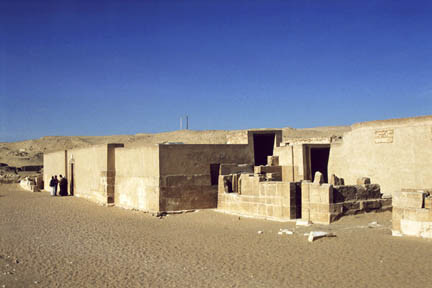
|
This is the tomb of Mereruka who died around 2323 BC. He was buried in a type of tomb known as a Mastaba - a name that comes from the fact that it looks like a bench and ‘Mastaba’ means ‘bench’ in Arabic. This was a traditional style of tomb for the early ancient Egyptians before they started to experiment with building pyramids.
|
|
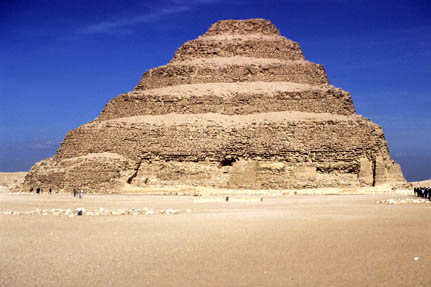
|
The very first pyramid in Egypt was built for King Zoser (Djoser) around 2650 BC. It is known as a Step-Pyramid as it does not have a true pyramid shape but rises to the top in five giant steps (see the people to the left of the pyramid to give you an idea of how large it is).
The step pyramid is basically five Mastabas - one on top of the other, with each one getting smaller as you near the top. And this is exactly how the whole idea for a pyramid came about in the first place. Look closely at Zoser’s Step-Pyramid. Can you see the original Mastaba that was built for the king in the lower-right section of the pyramid? The king’s architects first extended this original Mastaba, and then placed another on top - and then another.
By building a monument shaped like a pyramid the Egyptians would have believed that they were re-creating the shape of the first land that emerged from the sea at the beginning of time. This would ensure the king’s journey to the next world and a prosperous nation for everybody else.
|
|
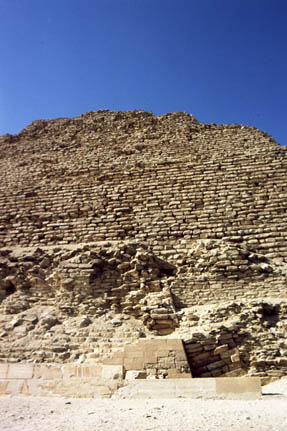
|
This is a close-up of Zoser’s Step-Pyramid. Here you can see the sloping wall of the original Mastaba. To the right of this is another extension before all of it was included in the building of the pyramid. When it was completed the pyramid would have been covered with fine limestone sheets and none of this earlier work would have been visible.
|
|

|
The first attempt to build a smooth sided pyramid - which has withstood the test of time - was by King Sneferu (2613-2589 BC) at Dahshur, just to the south of the main pyramids at Giza. It is known as the Bent-Pyramid due to the way the architects changed the angles of the sides halfway through.
No one really knows the reason for this but one suggestion is that a nearby pyramid at Meidum, which was also being built with smooth sides, collapsed while the Bent-Pyramid was being built. This prompted the architects to realise their mistake and change the angle of the sides. Had the original angle been completed it would have surely collapsed at some point.
|
|
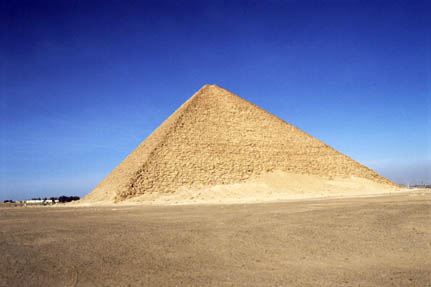
|
Just next to the Bent-Pyramid at Dahshur is the Red-Pyramid built by the same king - King Sneferu. Most people think he built this pyramid after the failures of the Bent-Pyramid. It is the first true pyramid with smooth sides. It is also the second largest pyramid ever built in Egypt.
|
|
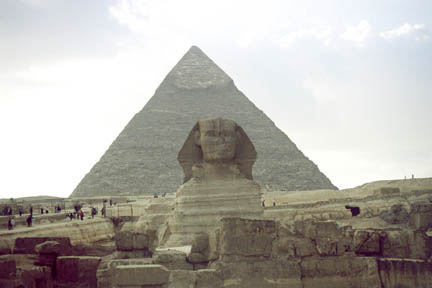
|
To the north of Dahshur is the Giza Plateau and here the three famous pyramids of Khufu, Khafre and Menkaure were built from 2589 to 2503 BC. The Pyramid of Khufu, also known as Cheops, is the largest of them all and is known as the Great-Pyramid - the only wonder of the ancient world still standing.
In this photograph you see the pyramid of Khafre, the second largest at Giza - still with a tiny portion of the smooth limestone capping in place at the top (this would have once covered all the sides). At Giza you see that the pyramid was only part of a whole complex of structures which worked together. In Khafre’s case there is a unique addition - a Sphinx. Partly carved out of a natural bit of rock, this magical creature watched over Khafre’s Valley Temple.
|
|
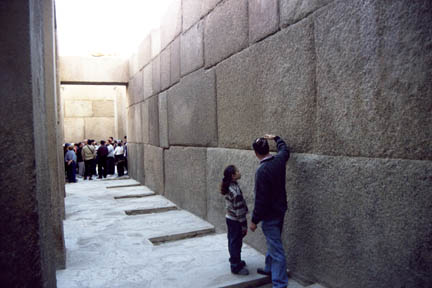
|
Each pyramid at Giza was connected to the Nile River by a canal. This canal ended at the King’s Valley Temple. It was in this temple that the major ceremonies at the King’s funeral took place, and it was here that prayers would be said for the dead king long after his death. This Valley Temple of Khafre is one of the world’s first examples of a building constructed with massive blocks of stone. Yet, even this early, the builders of Egypt proved themselves to be expert craftsmen and built a structure where the stones still join perfectly. In the shallow depressions on the floor would have stood statues of Khafre.
|
|

|
From the Valley Temple a causeway led to the Pyramid. The King’s body would have been carried up this sloping ramp, and in ceremonies to remember the dead king, processions would have walked this way to the pyramid. This is the causeway of Khafre.
|
|
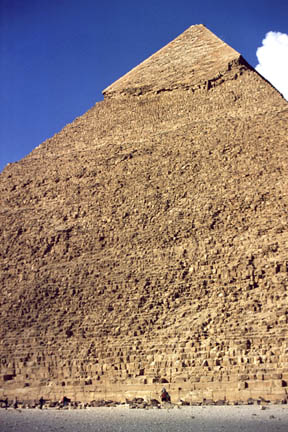
|
The final part of the complex was the pyramid itself. In this case, the pyramid of Khafre still retains the original limestone cover which once covered the pyramid making them into towers of gleaming white on which the sun-god Ra must have reflected his glory.
|
|

|
The largest of the pyramids at Giza is that of King Khufu, or Cheops (2589-2566 BC). To the right of the pyramid is a modern structure protecting a solar-boat, one of several wooden boats that were buried next to each pyramid in pits. The boats were either the boats on which the king’s body reached the pyramid, or they were there in case the king needed them in his journey through the next world.
|
|

|
The people and camel at the bottom of this photo show the size of King Khufu’s pyramid. It stands 127 metres tall (originally 140 m) and is composed of two and a half million stone blocks averaging two tonnes in weight each. Massive ramps would have given the builders access to the the structure and many things such as burial chambers and passageways had to be built inside. The pyramid was a tomb for the king, but a king who would become a god and bring harmony to the people he left behind.
Even though they did not have iron tools or modern instruments, the pyramids were constructed with amazing architectural accuracy. No other monument can inspire wonder like the pyramids, especially when you consider that they are over four and a half thousand years old.
|
|
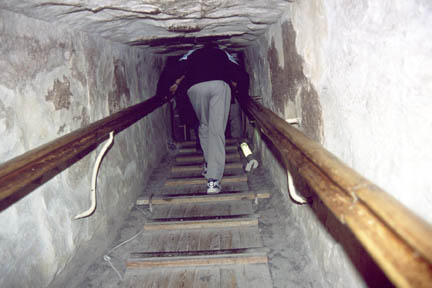
|
Inside Khufu’s pyramid is a passageway that leads up inside the pyramid to the king’s burial chamber. At first this passageway is confined, but it soon opens out.
|
|
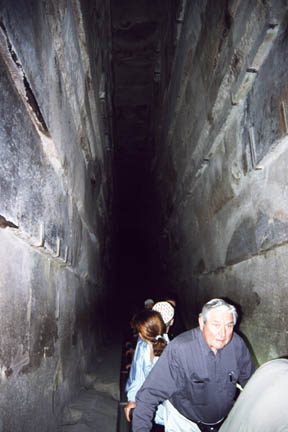
|
As you near the burial chamber inside Khufu’s pyramid, the passageway is constructed out of very large blocks of stone - and it it is very hot and stuffy inside with all the other visitors.
|
|
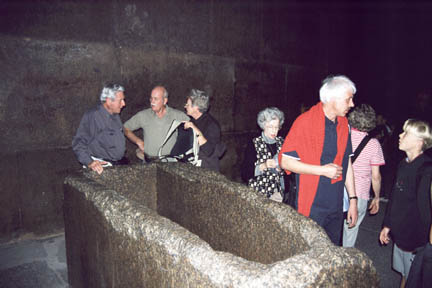
|
At last, about halfway up inside the pyramid, is the burial chamber of King Khufu. There are no images on the walls and no inscriptions - only a beautifully built chamber constructed from fine granite stone. In this chamber is the sarcophagus, or coffin, of the king; also made out of granite stone. This sarcophagus is too large to have been brought into the pyramid when it was completed, so it must have been built into this chamber as the pyramid was being built. Even though the chamber had been robbed long before modern times, it is unlikely there were lots of treasures left here. Rich funeral goods, such as found in Tutankhamun’s tomb, are a trademark of much later kings.
|

